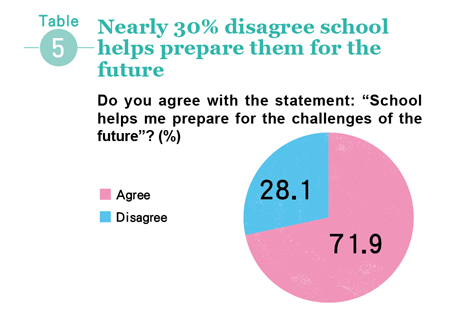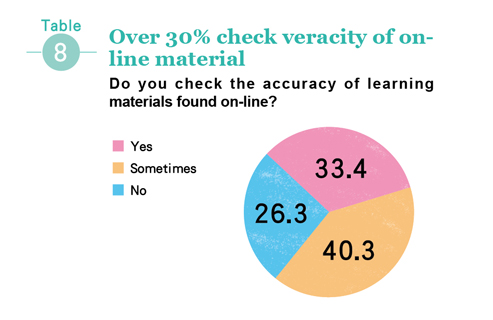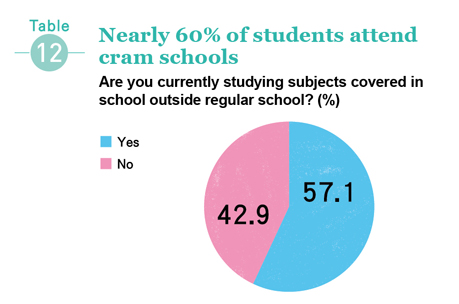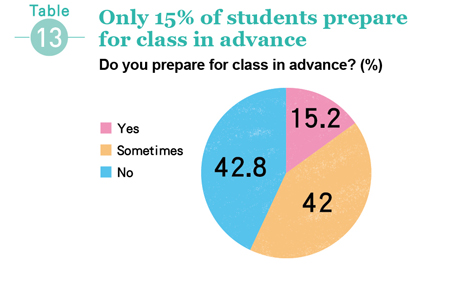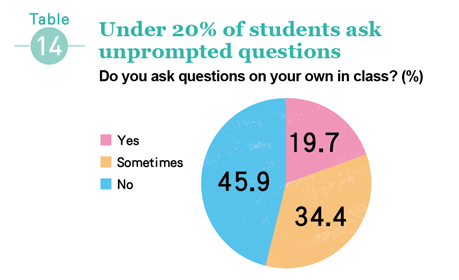2013 CommonWealth Survey of Junior High Students
Prospects Dubious Without New Approaches
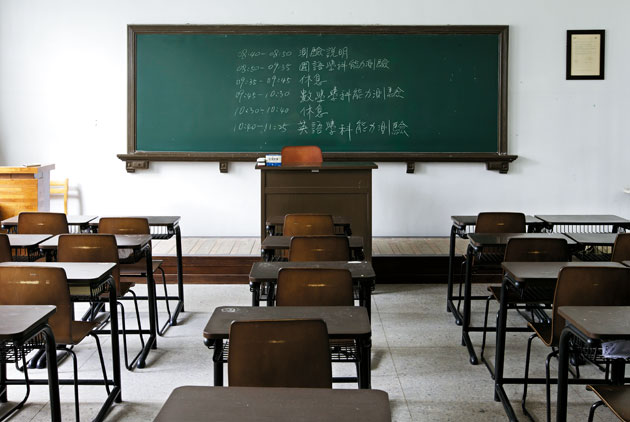
Source:CW
Taiwan's 12-year national education system formally goes into effect in 2014. At this juncture, CommonWealth has undertaken a survey that takes us into the classroom in search of a new direction for Taiwanese education.
Views
Prospects Dubious Without New Approaches
By Rose SheuFrom CommonWealth Magazine (vol. 536 )
Taiwan's new 12-year compulsory education system goes into effect in 2014, eliminating standardized placement testing. Current junior high school students will be the first generation to pass through the system without having to sit for high school placement examinations. How does this group of 13 to 15 year-olds look at the educational reforms they will encounter? In an effort to gain a clear picture of the impact of the reformed system on junior high school students around Taiwan, CommonWealth conducted a survey in cities and counties around the island. The survey, which compiled questionnaires from 2500 junior high school students, resulted in five major findings.
Finding 1: Parents Put More Pressure on Students than Teachers
The survey found that although the 12-year national educational system is being described as having eliminated testing to determine advancement through the system, 43 percent of students indicated feeling significant pressure on them from schoolwork, with female students feeling more pressure than their male counterparts (Table 1).
In order of rank, top to bottom, the primary sources of academic stress include: examination pressure, parents' expectations, self-imposed demands, competition with other students, and teachers' demands (Table 2).
Surprisingly, "teachers' demands" ranked last among sources of junior high school student pressure, with only 6.9 percent of those surveyed identifying teachers as the chief source of stress.
Professor Hui-Ling Wendy Pan of the Graduate Institute of Educational Policy and Leadership at Tamkang University, says that if seen in a positive light this finding could show that teachers are not as fixated on grades as they once were, meaning they are more enlightened. On the other hand, this could also have negative reasons, indicating that since students are unable to learn anything at school they are completely indifferent to their teachers.
Hsueh Chun-Kuang, president of the Secondary and Elementary School Principals Association of R.O.C., notes with sadness that such low numbers show the waning function of teachers. "Teachers should give some thought to why their influence has diminished so greatly. What is the value and meaning of being a teacher?
What do junior high school students think of their teachers? Have they become more enlightened, or are they increasingly irrelevant?
One grade-eight student at a public junior high school in northern Taiwan, surnamed Lin, offered his first-hand interpretation: "I think it is good that the figure for teachers as the main source of pressure on students is six percent. Because normally teachers only expect us to achieve the average or a bit higher than average, whilst parents want us to be at the top. Plus, examination pressure usually has to do with parents; because when you do poorly on a test your parents make you miserable right away, whilst teachers are usually nicer."
Finding 2: 30 Percent of Students Unable to Follow Classes
One of the key objectives of the reformed education system is to enliven the junior high school learning environment to boost effective learning. However, according to our survey, over 30 percent of junior high students have trouble following their classes (Table 3).
A startling 30 percent of students feel that "school is a waste of time" (Table 4). Moreover, the significantly higher ratio of this opinion among male students (37%) versus females (25%) shows the lower appeal of school to male students, indicating a learning crisis among them.
Although 70 percent of students agreed that "school can help me prepare for the challenges of the future," it was found that the higher the students are in the system the lower their confidence in education (Table 5).
Responding to these findings, Yao-Ting Sung, Director of the Psychological and Educational Testing Research and Development Center at National Taiwan Normal University offers that, without a greater diversity of learning opportunities, the lower students' grades are the greater the likelihood that they find school a waste of time.
"However, the proportion of students that falls under this description should not be as high as 30 percent. Students that find school a waste of time could include those at both extremes of the class, on one side the ones that cannot follow the lessons, with the other being the top students for whom class is unnecessary," says Sung.
Is school really a waste of time? Student Lin relates, "If school means just listening to a teacher talk, then to me about half of it is a waste of time. For instance, our civics teacher just reads PowerPoint presentations verbatim from the slides. Even if he did not hold class we could understand the contents. However, if school means the entire process of attendance then I do not find it a waste of time, mostly due to interaction with other students and all kinds of unexpected discoveries."
Looking at the above statistics, both Wendy Pan and Yao-Ting Sung would give current junior high school education a grade of just 68 points.
Finding 3: Digital Learning
A major departure in essence separates the first generation of students under the new 12-year national education from their parents and teachers, particularly in terms of learning tools and methods.
The survey indicates that over 90 percent of the junior high school students use Facebook; over 40 percent of them have their own computer (including tablet devices); and over 50 percent have a smart phone (Table 6).
No discernable gap separates Taiwan's five largest urban areas and other areas in regards to the above figures.
In the realm of changing learning methods, around 30 percent of students learn with the aid of the Internet or their mobile phones. Interestingly, there is a marked gap between males and females in this area, with a higher ratio of females using these tools (Table 7).
A divide also separates students in urban and rural areas, with 34 percent of students in Taiwan's five largest urban centers utilizing digital learning tools compared to 29.2 percent of students outside those areas.
With the growing prevalence of on-line learning, over one-third of junior high school students make efforts to ascertain the veracity of Internet content (Table 8).
Hsueh Chun-Kuang notes that these figures tell teachers that the ways in which students are learning are changing. Accordingly, teachers must give thought to how to change teaching methods. For instance, how to utilize technology so that active, diverse, seamless learning can transpire anytime, anywhere.
Finding 4: School Teaching Methods Remain Static
In contrast to the changes among students there have been no significant changes in schools' teaching approaches to date.
The survey found that nearly one-half of junior high schools continue to post student rankings according to grades (Table 9). Moreover, this is more common outside of Taiwan's major urban areas (51.5 percent) than in the cities (45.8 percent).
Classes still mostly consist of a teacher presenting a lecture and students listening. The next approaches in degree of popularity are mixed teaching, group discussions, hands-on practice, and competitive games (Table 10).
Students find mixed teaching methods most effective, followed by hands-on practice, competitive games, teacher lectures, and group discussions and presentations (Table 11).
Wendy Pan believes that such a high proportion of schools continues to post student grade rankings because it "intensifies competition, using external means to stimulate students' learning motivations. This is a very misguided approach." However, she also notes that excellent teachers are necessary to trigger students' learning motivations.
One other quite unexpected research finding is that "group discussion and presentations" was ranked last by students among effective teaching approaches, behind even one-way teacher presentations.
Wendy Pan, currently helping major educational institutions to promote a "learning community," was not surprised at the results. "I'm wary of ineffective group cooperative learning. If it means just breaking students into groups to present separate reports, it is not systematic and is therefore less effective than a teacher lecture," she says.
Finding 5: students' learning initiative remains low
Although the reformed system eliminates the Basic Competence Test, junior high school students will still participate in the Comprehensive Assessment Program for Junior High School Students and take entrance examinations for students with special talents and skills. Hence, many still suspect that the reformed 12-year education system will actually increase junior high school students' reliance on cram schools.
According to the CommonWealth survey, 57 percent of junior high school students still attend afterschool cram school lessons. This has remained essentially static since the 2008 survey conducted by CommonWealth Parenting that found 57.15 percent of junior high students attended cram schools (Table 12).
Wu Fu-bin, president of the National Alliance of Parents Organization notes: "The cramming phenomenon has always been around. The CommonWealth survey shows that the 12-year national education system has not exacerbated cramming, and we can expect this number to drop if it is handled well."
Nevertheless, it is worrisome that students' learning initiative has not increased.
According to the survey, only 15 percent of students prepare for lessons in advance, and the ratio diminishes as the grade gets higher (Table 13). Only about 20 percent of students ask questions on their own, and a significant gap divides the country's urban centers (23.2%) from other areas (15.8%) (Table 14).
Wu observes that students' reluctance to prepare for classes and their dislike of asking questions is a concern for Taiwanese education – especially in remote areas – as it touches upon students' attitudes toward learning and the formation of habits.
Does the advent of the non-testing era herald the arrival of an age of self-motivated study?
The survey showed that around 40 percent of students believe that upon the institution of the 12-year national education system they can truly study for themselves, rather than to take exams; moreover, the younger the students the more optimistic they were about this. Are such figures high or low? (Table 15).
"I'm surprised to see figures like these. At this age it is not easy for 40 percent of children to study for themselves," relates Wu.
Professor Pan holds that the older a person gets the harder it is to study for oneself, meaning that while there is no longer standardized testing, the stress on other forms of tests is still great.
Looking at the overall survey findings, "there is still a long way to go to get students to find learning worthwhile and interesting," Pan laments.
Translated from the Chinese by David Toman





